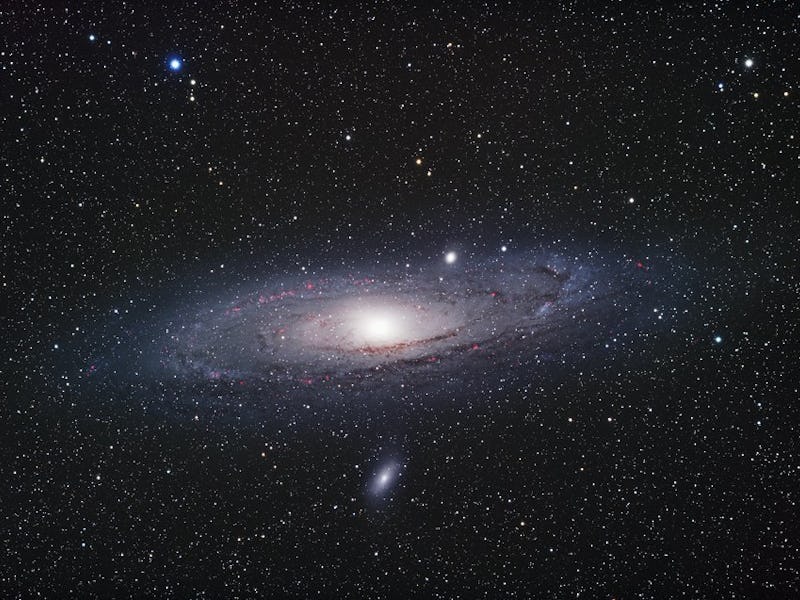The universe has been expanding since day one, the Big Bang. And now, researchers can more accurately measure how fast our universe is growing — which could perhaps soon lead to a newer understanding of the physical world like no other.
Right now, the scientists says that the universe is expanding at about 72 kilometers per second per megaparsec (or 3.3 million light-years). This rate, which also points at the universes scale and age and can measure the distance to remote objects, is called the Hubble constant.
An international cosmology project called the H0LiCOW collaboration announced Thursday it has used new tools to calculate the Hubble constant more precisely. Their research will appear in a series of papers to be published in the Monthly Notices of the Royal Astronomical Society.
This new measurement could potentially point towards a new field of physics research we’ve never seen before. While these findings agree with some recent studies of the Hubble constant, they are an intriguing disagreement with cosmic microwave background measurements made in 2015 by the Planck satellite. This hints at a fundamental problem in how we understand the universe.
“The main implication is that there is this tension between the early universe measurement and local measurements,” Sherry Suyu at the Max Planck Institute for Astrophysics in Germany, who led H0LiCOW, tells Inverse. “There’s something we don’t quite understand. If the tension holds up, there’s something missing in the model of our universe. This is why this might indicate new physics.”
To measure the constant, the H0LiCOW collaboration has been using various telescopes and “gravitational lensing,” or how massive galaxies bend light from distant objects. This happens when a light ray passing close to a galaxy is deflected and does not travel in a straight line anymore. The galaxy acts as a lens that magnify and distort images of objects further away, and it can also produce several images of an object, making it appear multiple.
“The light rays emitted by a source of light located behind the lens galaxy are going in every direction but some of the light rays will be ‘focused’ by the lens galaxy, and will converge towards us,” Vivien Bonvin of École Polytechnique Fédérale de Lausanne de Lausanne in Switzerland tells Inverse. “Hence, we can see multiple images of the source, even if the source is unique.”
Using this method, the H0LiCOW researchers studied the light from five quasars, or black holes at the center of galaxies that emit large amounts of electromagnetic energy, which makes them especially luminous. Some galaxies bend or slow light more than others, causing light from the quasars to arrive at slightly different times. The distance lights from these quasars travel depends on the Universe’s expansion, so by measuring the time-delay between the lensed images of quasars, researchers determined the Hubble constant with 3.8 percent accuracy.
To continue improving the accuracy of the measurement, the H0LiCOW team plans to study up to 100 lensed quasars. Since the research is in tension with the cosmic microwave background measurements made by the Planck satellite, Bonvin says scientists may have to change current assumptions on dark energy, which accelerates the universe’s expansion. If this is the case, then the universe is expanding 6 percent faster than previously expected, and in 20 billion years, no ordinary matter can survive because everything will be torn apart — galaxies, stars, everything. This scenario is just a possibility though.
“As the estimates from different methods become more and more precise, it will be interesting to see if the results will disagree even more, or if they will be brought back into agreement,” Cristian Eduard Rusu, a postdoctoral researcher at University of California, Davis, and lead author of the third paper in the series, tells Inverse. “If they continue to disagree, we will need to seriously consider rethinking our standard model of cosmology, and try to uncover the unknown physical mechanism that causes the disagreement. Hence, new physics.”
In the 1920s, astronomer Edwin Hubble first observed that galaxies were moving away from the Milky Way, and those that were further away were moving faster. The galaxies weren’t trying to get away from us — it was just the universe expanding outwards. Hubble calculated a rate for the universe expanding — and now it’s called the Hubble constant in his honor.
Since then, this measurement has been refined with more advanced technology, like the Hubble telescope and the cosmic microwave background, a background temperature of the universe known as the “afterglow” or “fossil radiation of the Big Bang.
